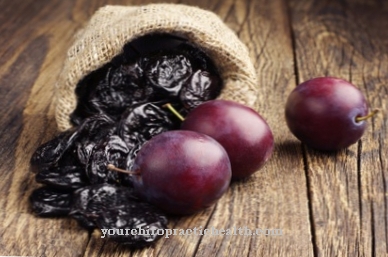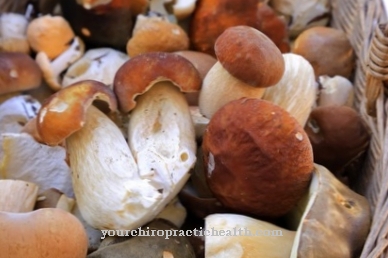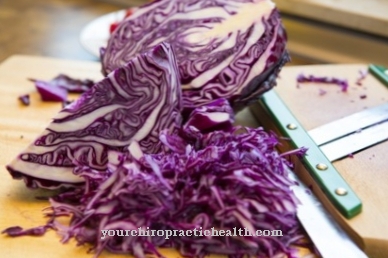Of the Water spinach is a green vegetable that enriches Asian dishes in particular. It belongs to the genus of morning glory and can be annual or persistent. Other names - especially in the culinary field - are Phak Kwang Tung or Kangkung.
What you should know about water spinach

Water spinach belongs to the genus morning glory, which botany also knows under the name of magnificent winds or Ipomoea. The genus includes around 650 different types of plants, including the sweet potato, and belongs to the bindweed family.
The water spinach especially thrives in damp locations up to 1550 m. The green leafy vegetables presumably come from Asia and are now at home in tropical and subtropical areas. It is very common there. While the water spinach grows herbaceous on the ground in some locations, it can also swim on the water in rice fields, ponds or slowly flowing water. It is not only adapted to different locations, but can also cope with changing environmental conditions. The plant can be annual or perennial. Annual water spinach flowers only once and then withers; Farmers have to re-sow it every year.
However, this need not be an economic disadvantage if farmers are harvesting the whole plant anyway. On the other hand, they can only collect individual leaves from the persistent water spinach. In this case, the plant remains intact and lives on. In this way it lasts for several years.
Persistent water spinach can bloom and produce seeds several times a year under good conditions. In this way it differs from perennial plants, which are also several years old, but only bloom once a year. The leaf shape of the water spinach is elongated, but can vary in individual cases - depending on the growth conditions and adaptation.
The leaves are either lanceolate or ovate. Sometimes the leaves have fine hairs that help the plant regulate its fluid balance through evaporation. The water spinach is a relatively undemanding plant and thrives almost all year round, provided the temperatures do not drop below freezing point. In greenhouses (including cold greenhouses without artificial heating), farmers also grow water spinach all year round.
Importance to health
The carbohydrates in water spinach are predominantly complex carbohydrates; the human body can only digest them slowly because enzymes first have to break down the individual carbohydrate components. Only then can the digested carbohydrates pass through the intestinal wall into the blood.
Complex carbohydrates are in contrast to simple carbohydrates such as sugar. These carbohydrates only consist of short chains of sugar molecules - the body hardly has to break them down and can therefore absorb them more quickly. Complex carbohydrates raise the blood sugar level comparatively slowly and keep it constant for longer. Eating water spinach and other foods that contain more complex than simple carbohydrates helps prevent diabetes and other metabolic diseases.
Some carbohydrates in water spinach cannot be digested by humans. They are dietary fibers that have no nutritional value in themselves. Nevertheless, they are of great importance for the functioning of the intestines: They stimulate muscle movements and thereby prevent constipation and other digestive problems. The German Nutrition Society (DGE) recommends the consumption of 30 g of fiber per day. In addition, water spinach contains numerous phytochemicals such as chlorophyll. Nutritionists and medical professionals still do not agree on the importance of these substances for the human organism.
However, some studies show possible positive effects of phytochemicals on health, especially with regard to cardiovascular diseases and cancer. However, these data are not considered certain and will require more detailed research in the future.
Ingredients & nutritional values
| Nutritional information | Amount per 100 gram |
| Calories 19 | Fat content 0.2 g |
| cholesterol 0 mg | sodium 113 mg |
| potassium 312 mg | carbohydrates 3.1 g |
| protein 2.6 g | Fiber 2.1 g |
Water spinach contains around 48% carbohydrates - including numerous complex carbohydrates - and 24% protein in the dry matter. 100 g of fresh water spinach therefore contains an average of 3.4 g of carbohydrates and 2 g of fiber.The intact plant consists of 90% water and is very low in calories: 100 g contain only 19–20 kcal. This makes water spinach ideal for a calorie-conscious and low-carbohydrate diet.
Intolerances & allergies
A specific allergy to water spinach is very rare and does not belong to the usual allergies. However, if typical allergy signs such as reddened skin, hives, swollen skin, eyes or throat become manifest after consuming water spinach, a medical evaluation is necessary. Intolerance is more common in the form of digestive problems.
However, these can also be due to the fiber and complex carbohydrates contained in water spinach. People whose previous diet was deficient in such substances usually have to get used to this change. However, the digestive system learns to deal with the new food after a short time. The digestive problems often disappear after about two weeks of regular consumption of complex carbohydrates and fiber (at least 30 g per day).
If the person concerned suffers from sensitive complaints such as swelling of the esophagus or is not sure, he should for safety reasons rather not enjoy the water spinach.
Shopping & kitchen tips
In the trade, water spinach is often also available under the name Phak Kwang Tung or Kangkung. The Asian cuisine makes the most use of water spinach. It is used in numerous dishes, often with other vegetables, but also only with rice.
Fresh water spinach should be stored in the refrigerator. A closed container in the vegetable drawer is best for this, as the cooling for the green leafy vegetables is ideal there. The leaves tend to wither very quickly - which is not only visually less appealing, but also has a negative effect on the ingredients: Many vitamins disintegrate very quickly when the uprooted plant is exposed to free air circulation. Sunlight also breaks down some nutrients like vitamins and changes them on a biochemical level, which inactivates them biologically. They then no longer have the desired health effect for humans.
Preparation tips
Water spinach complements vegetable and rice dishes and is suitable for both steaming and frying. In the modern kitchen, a microwave is sufficient for steaming. To do this, the water spinach is placed in a cooking bag or a microwave-safe container and steamed briefly at low power. In the saucepan, cooks steam the vegetables by filling the saucepan with a small amount of water and placing the water spinach over it in a sieve or cooking basket.
The water spinach must then stand for about a minute and is then ready for further use. A simple dish with water spinach consists of rice and steamed water spinach, which (depending on the region, season and occasion) can be enriched with spices. A teaspoon of sesame oil rounds off the meal.



























